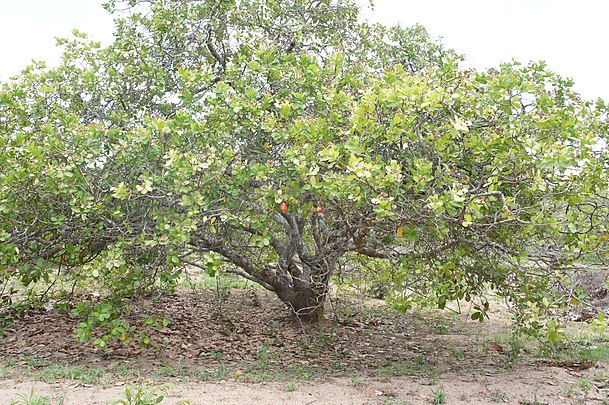Anacardium occidentale

|
|
Anacardium occidentale Common Names: Cashew, Cashew Nut Tree, Cashew Apple
Tree, Maranon
Species ID: NMP-007 | wfo-0000533072 | NCBI:txid171929 Scientific
Classification Kingdom: Plantae Phylum: Tracheophyta Class: Magnoliopsida Order: Sapindales Family: Anacardiaceae Genus: Anacardium Species: A. occidentale Synonyms: Acajuba occidentalis (L.) Gaertn., Anacardium microcarpum Ducke, Cassuvium pomiferum Lam., Anacardium othonianum Rizzini Morphological Description Anacardium occidentale, commonly known as the cashew tree, is a tropical evergreen tree,
typically growing 6–14 m tall, with dwarf cultivars reaching 4–6 m for
commercial efficiency. Its key features include: · Stem: Short, often irregularly shaped trunk, with a spreading,
globose crown 6–15 m in diameter · Leaves: Simple, alternate, obovate to elliptic, 4–22 cm long, 2–15
cm wide, leathery, with smooth margins · Flowers: Small, pale green turning reddish, 7–15 mm long, in panicles
or corymbs up to 26 cm long · Fruit: Kidney-shaped drupe (cashew nut), 2–3 cm long, encased in a double
shell, attached to a pear-shaped, yellow-to-red pseudofruit (cashew apple),
5–11 cm long Distribution and Habitat Anacardium occidentale is native to northeastern Brazil and southeastern Venezuela,
with centers of diversity in Central Amazonia and the Planalto of Brazil.
Portuguese explorers spread it in the 16th century to India, Africa, and
Southeast Asia, and it is now cultivated in tropical regions like Vietnam,
Nigeria, Ivory Coast, Indonesia, and the Philippines. It thrives in: · Ecosystems: Coastal restingas, savannas, cerrados, and secondary forests · Climate: Tropical to subtropical, with rainfall of 500–3,500 mm
annually and temperatures of 20–35°C · Soils: Well-drained, sandy to loamy, tolerating poor, acidic soils · Altitude: Sea level to 1,000 m Ethnopharmacology Anacardium occidentale, commonly known as the cashew tree, is a medicinal plant whose
various parts, bark, leaves, seeds, and nuts, are widely used in traditional
medicine. It exhibits antimicrobial, anti-inflammatory, antioxidant, antidiabetic,
hypocholesterolemic, and wound-healing properties. The bark and leaf extracts
are traditionally used to treat diarrhea, dysentery, ulcers, inflammatory
conditions, toothaches, and sore throats, while the seeds (cashew nuts) are
valued for promoting heart health and providing nutritional benefits. The
plant's parts are also employed to manage high blood pressure, diabetes, and
skin infections. Phytochemical studies have identified active compounds such as
flavonoids, anacardic acids, tannins, saponins, and phenolic compounds, which
are responsible for its therapeutic effects. Although widely used in folk
medicine, further scientific research is encouraged to confirm its
pharmacological actions and optimize its safe usage. Antioxidant and Anti-inflammatory Effects: Oral administration of cashew nuts (100 mg/kg)
in mice with induced colitis reduced inflammation, decreased oxidative stress
markers, and modulated inflammatory pathways (Siracusa et al., 2020). · Antimicrobial
Activity: Crude extracts from
Anacardium occidentale leaves and bark exhibited significant antibacterial
activity against various pathogens, including Staphylococcus aureus and
Escherichia coli (Amorim et al., 2022). · Anticancer
Properties: Anacardic acid, derived
from cashew nut shells, demonstrated cytotoxic effects against certain cancer
cell lines, potentially through antioxidant mechanisms (Wikipedia, n.d.-a). · Antidiabetic
Effects: Hexane leaf extracts of
A. occidentale showed hypoglycemic effects in diabetic rat models, supporting
its traditional use in managing diabetes (Tedong et al., 2007). · Aphrodisiac
Activity: Ethanolic leaf
extracts improved sexual function in stress-exposed male rats by increasing
testosterone levels and reducing oxidative stress (Wattanathorn et al., 2019). ⚠ Toxicity Profile: The cashew nut shell contains anacardic acid and
cardol, caustic phenolic lipids causing contact dermatitis similar to poison
ivy, necessitating careful processing. The LD₅₀ of hexane leaf extract in mice
was determined to be 16 g/kg body weight. High doses led to symptoms like
asthenia, anorexia, diarrhea, and syncope (Tedong et al., 2007). Prolonged
administration of high doses (10–14 g/kg) resulted in reduced food intake,
weight loss, and histopathological changes in liver and kidney tissues (Tedong
et al., 2007). Cashew nuts can cause allergic reactions in sensitive
individuals, ranging from mild symptoms to severe anaphylaxis. Additionally,
the shell contains anacardic acid, which can cause skin irritation upon contact
(Wikipedia, n.d.-b) Additional Uses · Culinary: Cashew nuts are consumed as snacks, in curries, or processed
into cashew butter, milk, and cheese. The cashew apple is used for juices,
jams, chutneys, and liquors like Feni in India. · Industrial: Cashew nut shell liquid (CNSL) is used in lubricants,
paints, resins, and adhesives. Cardanol from CNSL is explored for nanomaterials
and biotechnology applications · Agroforestry: The tree improves soil fertility, aids reforestation, and
provides shade for crops like cocoa in Nigeria and India. · Animal Feed: Discarded cashew kernels and leaves are used as livestock
feed in West Africa References
External Links More Pictures |
|
| Compounds of Anacardium occidentale |
|
| References |